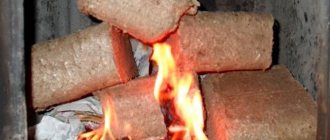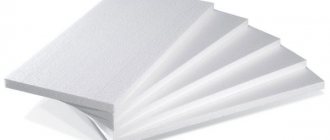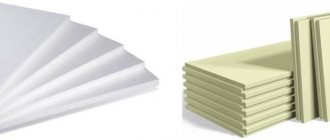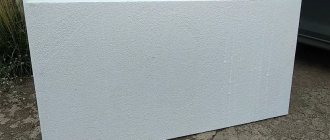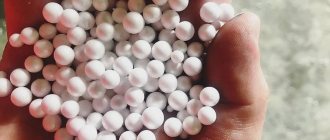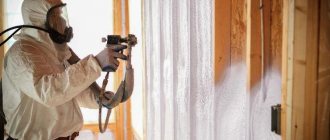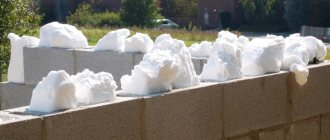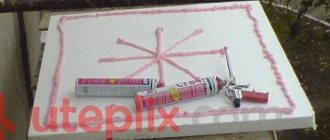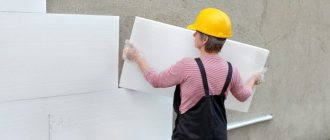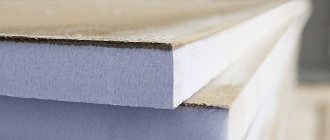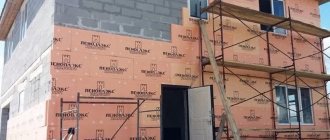The scope of application of polystyrene foam is very diverse:
- construction sector (thermal insulation material for floors, roofs, foundations);
- trade sector (packaging material for goods);
- the sphere of production of goods (production of furniture, refrigerators, life jackets, tailoring, etc.);
- shipbuilding (production of buoys, pontoons, boats);
- outdoor advertising.
Do-it-yourself material recycling
If you want to know exactly how you can recycle polystyrene foam, we suggest you consider the step-by-step instructions. All you need is enough foam and a crusher. Then you can get polystyrene foam granules and use them for your own purposes. If you don’t have your own foam crusher, you can make one yourself. After all, factory models have a very high price.
Here's what you'll need to have a new useful tool on your farm:
- sewer PVC pipe, diameter 50 mm;
- tape measure and marker;
- metal file;
- a wooden beam that would fit inside the pipe;
- metal screws;
- screwdriver and drill;
- metal studs with bolts;
- Chipboard or plywood to create a box.
Using this set of tools and materials, you can create a working foam crusher. With its help, sheets or others will turn into crumbs. The mechanism is based on a moving part with teeth, which crush the foam into granules. And thanks to the container or box, it is easier to direct the material to the rotating mechanism. You will learn exactly how to create a crusher in this video.
So, when the crusher is ready, you can start working. Here's what to do:
- Choose a suitable location. Alternatively, choose a garage, warehouse, storage room or shed.
- Install the crusher, taking care of the container underneath it, where the crumbs will fall. This could be a bucket, bag or wooden box.
- Foam sheets are easy to crush. But as for figured products, it is better to break them into pieces with your hands in advance.
- Now all that remains is to turn on our homemade unit and gradually process the raw materials.
Thanks to this technology, most of the granules will remain intact. This means that they will cope with their task better than ever. You just need to be careful, as the foam is electrified and very light
It is important to make sure that there are no drafts in the room, otherwise you will have to remove everything from the floor later. Now the foam can be collected in bags and used immediately or stored until it has its time
Note! If you melt the foam with acetone, it can be used in liquid form as glue. Although the mixture cannot be called safe
Materials for production
Since there are several types of such material, accordingly, it is produced from various raw materials. The most popular today are products from:
- polystyrene;
- polyurethane;
- polyvinyl chloride;
- polyethylene.
Let's take a closer look at the production of each of these types of foam:
- Polystyrene foam is made from styrene polymers. This substance has minimal strength and can be easily dissolved with gasoline or acetone. This type of foam is formed by gas-filling styrene granules. Also, the procedure for obtaining such substances involves the use of additional substances that improve the structure or color the product itself.
- Polyurethane foam has good technical characteristics, which depend on the procedure for obtaining such a substance. Polyurethane polymers are very often used in various industries. The structure of foam made from such substances can be different (hard or elastic), which is obtained from certain types of these raw materials. This material is obtained by foaming using special gases.
To obtain polyvinyl chloride foam, they resort to heating the raw material and then foaming it under the influence of various gases. To obtain a material with the original characteristics, the resulting mixture can be pressed.
The mechanical properties of polystyrene foam are also controlled using special substances that are added during its production process.
Polyethylene is used as a raw material for the preparation of such products. The foam made from it is soft and almost colorless.
Such products are used as wrapping for packaging various plumbing fixtures and household appliances. Such material is also obtained under the influence of gases that penetrate the pores of polyethylene.
Polystyrene foam is popular as insulation, and therefore it is often used to insulate the facades of houses.
Watch the video to see how polystyrene foam is made:
All stages of foam production technology are considered. The equipment needed to produce this material is listed. Recommendations are given that you should definitely read before purchasing.
Many of us have come across expanded polystyrene more than once, tried it to the touch, made something from it, used it in construction, for home improvement. However, not everyone knows what the foam manufacturing technology is and what its features are.
Oddly enough, there is nothing super complicated in the production of this material. And it is noteworthy that now quite a lot of low-quality polystyrene foam has appeared on the market, which is made without taking into account the relevant norms and regulations.
Some craftsmen manage to create a small production line even in an ordinary garage. Yes, don't be surprised.
And this must be taken into account when purchasing - not all Vasya Pupkins strictly adhere to the prescribed technological standards. And what standards can there be in a garage?
Business organization
Starting production requires a preliminary solution to a number of organizational issues. The main ones are:
- conducting an analysis for the presence of similar enterprises in a particular region;
- drawing up a detailed business plan with all the necessary calculations;
- choosing a legal form and registering activities with the tax authority;
- acquisition or rental of space for production;
- hiring employees;
- purchase and installation of equipment;
- launch of advertising.
Registration of activities
Registering a business involves choosing one of the organizational and legal forms: individual entrepreneur or LLC. It is recommended to register the production of polystyrene foam as an LLC; this will eliminate the problems of selling products in cooperation with state enterprises and large organizations. The process consists of several stages:
- preparation of the necessary package of documents;
- contacting the tax authority and choosing a taxation system;
- Receiving a certificate of registration within 5 working days.
The following documents will be required:
- statement;
- founder's passport;
- information about the authorized capital;
- decision to establish a legal entity;
- charter of the company;
- a receipt confirming payment of the state fee.
When filling out documents, you should indicate the OKVED code - 25.21 (production of plastic products).
Production room
Depending on the size of the investment, premises for production can be purchased or rented. The optimal area will be 200 m2, it will include:
- workshop – 100 m2;
- administrative part – 25 m2;
- warehouse premises (storage of raw materials and finished products) – 75 m2.
The premises must meet a number of requirements:
- absence of moisture and rodents (appropriate treatment is carried out before opening);
- minimum distance from urban infrastructure (permissible location - up to 10 km);
- good condition of all necessary communications: electrical networks, heating and ventilation systems, hot and cold water supply;
- availability of convenient access for any type of cargo transport.
Staff
The number of employees hired will depend on the scale of production activities. When the enterprise operates in 2 shifts, the number of workers must be doubled. The staff will include the following units:
- worker;
- master;
- technologist;
- equipment adjuster;
- loader;
- storekeeper;
- supervisor;
- purchasing and sales manager;
- accountant.
In the future, it is worth purchasing your own transport and hiring 2 drivers to deliver products to customers. The cost of wages for 20 staff will be approximately 400,000 rubles.
Search for suppliers of raw materials
The main raw material for the production of polystyrene foam is PSV granules, which are similar to translucent beads. The cost of raw materials is determined by the fraction size (0.2-3.5 mm) and quality. The longer the granules have been stored, the more time it takes to process them to the required condition. In Russia, polystyrene is produced at several large enterprises. One of the most popular brands is considered to be PPS 25-F, which has a hard and smooth surface. You can also order raw materials from China. This option is characterized by maximum availability and cost-effectiveness. Chinese polystyrene is not inferior in quality to its Russian counterpart, but is cheaper. Addresses and contacts of future suppliers can be found on the Internet. Before concluding a supply contract, it is recommended to read reviews about the quality of the products planned for purchase. To produce 1 cubic meter of product, you will need 15 kg of polystyrene. The price per kg is approximately 70 rubles. To purchase the first batch of raw materials, you will need 200,000 rubles.
Raw materials and technology
Polystyrene foam is made from special expanded polystyrene foam. Its cost largely depends on the manufacturer and fraction. The price of raw materials for the production of polystyrene foam ranges from $2 per 25 kg.
When purchasing expanded polystyrene, pay special attention to its quality. Domestic raw materials can be purchased at a low price, but this may negatively affect the quality of the finished product
Imported polystyrene foam allows you to obtain high-quality material with a small amount of defects. Recently, the main raw materials have been purchased from China.
Pay attention to the quality of polystyrene, as well as the duration of its storage. The older the raw material, the longer the foaming process will take and the more difficult it is to achieve the density of the foam granule
What is needed to produce expanded polystyrene?
- Raw materials (expanded polystyrene foam);
- Steam (temperature about 110 degrees);
- Electricity (voltage 980 W);
- Cold water;
- Equipment.
Production technology
When the starting material enters the pre-expander, the granules are inflated and turned into balls. If necessary, this process is repeated. After foaming, the granules increase in volume. This foam production technology is used to produce low-strength material.
Video on the topic Video on the topic
Do I need permission?
Obtaining a permit to open a polystyrene foam business is not required, with the exception of a fire inspection. There is no need to contact the health authority, since this type of activity is considered practically harmless
( 3 ratings, average: 3.00 out of 5)
Loading…
Similar business ideas:
- TOP 30 business ideas with minimal investment
- Business ideas for men
- Where to start shoe production and is this business profitable?
- TOP 30 business ideas without investment
Using recycled polystyrene foam
Construction is a process that requires large investments. And if you have polystyrene foam, it will definitely find its use at a construction site. For example, foam chips can be used as filler for site depressions and uneven areas. It is clear that they cannot level the road, but it is easy to make a path or other unevenness. Recycled polystyrene foam can be filled into a well of different hole or cavity diameters.
Note! Over the years, the material will not change and will remain in the form and form in which it was left. It perfectly absorbs and thaws moisture
Therefore, metal containers with polystyrene foam are not so susceptible to corrosion.
In the construction business, recycled polystyrene foam is used to create lightweight bricks. Its structure is such that it is popularly called perforated. Even lightweight concrete has appeared, which, as experts say, is no less durable than regular concrete. This is polystyrene biton - an excellent building material. It consists of Portland cement, foam granules itself, water and an air-entraining additive. Sometimes sand is added to the mixture.
Another area of use is design. Designers love foam plastic very much and use it in a variety of ways. It is used to decorate walls, create pots, plant pots or similar accessories. Garden figurines or stands look very nice. They are created by pouring them into molds and heating them. You can find a variety of options for making polystyrene at home.
Let's sum it up
Polystyrene foam is a wonderful and versatile material. It can be used in a wide variety of fields. Its main advantage is its low cost, lightness, immunity to moisture and excellent noise reduction and sound insulation performance. And the fact that it can be reused makes the material simply irreplaceable in construction. So if you have a small amount of foam that's just lying around, why not give it a new life? Once processed, it can be used as dry insulation. And if you think carefully, there are a lot of use cases.
Recommended Posts
Laying gypsum decorative stone
Gypsum tiles under stone + photo
House made of expanded clay concrete blocks + reviews
Polymer concrete: composition, characteristics
We build a wooden house with our own hands
Colored mortar for bricklaying
How polystyrene foam is made
Previously we told. We remember that this material consists of numerous cells filled with air. This means that the manufacturing process must include foaming the material.
That’s right: the foaming process is one of the most important in the production of expanded polystyrene
.
However, that's not all.
Consider:
Stages of foam manufacturing technology
Typically the process includes:
Now in more detail:
1. Foaming.
During this process, the raw materials are placed in a special container (foaming agent), where, under pressure (a steam generator is used), the granules increase approximately 20-50 times. The operation is completed within 5 minutes. When the granules reach the required size, the operator turns off the steam generator and unloads the foam material from the container.
2. Drying the resulting granules.
At this stage, the main goal is to remove excess moisture remaining on the granules. This is done using hot air - it is directed from bottom to top. At the same time, for better drying, the granules are shaken. This process also does not last long - about 5 minutes.
3. Stabilization (tracking).
The granules are placed in bunkers, where the aging process takes place. The duration of the process is 4...12 hours (depending on the ambient temperature and the size of the granules).
Important note: the polystyrene foam manufacturing technology may exclude the 2nd stage (drying). In this case, stabilization (tracking) will last longer - up to 24 hours
4. Baking.
This stage of foam production is often called molding. The idea is to connect the previously obtained granules together. To do this, they are placed in a special mold, after which the granules are sintered under pressure and under the influence of high temperature water vapor. Lasts approximately 10 minutes.
5. Maturation (aging).
The goal is to rid the resulting polystyrene foam sheets of excess moisture, as well as remaining internal stresses. To do this, the sheets are placed in a free space in the production workshop for several days. In some cases, ripening can take up to 30 days.
6. Cutting.
The manufactured foam blocks are placed on a special machine, on which the blocks are cut into sheets of appropriate thickness, length, width. This manufacturing process is performed using nichrome strings heated to a specific temperature. Accordingly, both horizontal and vertical cutting of blocks is carried out.
This is how foam is made.
Of course, after the above 6 stages, the 7th stage can be performed - processing the remaining trimmings
. As a result, they are mixed with other granules, which will then undergo the same processes - sintering, curing...
The equipment that is used in the production of polystyrene foam is shown in table form:
Equipment selection
To produce polystyrene foam you need equipment:
- foaming agent for repeated foaming - 140 thousand rubles;
- receiving bunker – 30 thousand rubles;
- steam generator – 35 thousand rubles;
- aging bunker with a fan – 40 thousand rubles;
- block form – 10 thousand rubles;
- cutting machine, mechanical – 30 thousand rubles.
The full catalog of equipment can be viewed here.
To reduce the volume of production waste, it is recommended to purchase a crusher for crushing foam plastic scrap.
When making extruded foam, you need to use an extruder; the corresponding production line costs from $100 thousand. This equipment is characterized by high temperature and pressure, which make the resulting material stronger and more efficient in terms of thermal insulation.
There are machines on sale with different capacities, so you should determine in advance the volume of production of extruded foam.
The process of creating polystyrene foam
This material is made from expanded polystyrene by foaming it. Almost 98% of it consists of gas. There are 6 stages of creating polystyrene foam in an industrial environment:
Let's look at each of the stages. To begin with, the raw materials are poured into a foaming agent, after which the steam generator generates pressure at which the granules begin to increase from 20 to 50 times. The entire foaming process takes 5 minutes. When the desired size is reached, the raw materials are unloaded for drying. It is needed so that excess moisture on the granules evaporates. Everything happens due to hot air directed from bottom to top. Drying and shaking takes about 5 minutes.
Then the raw materials are moved to bunkers, where they are aged for 4-12 hours. The foam is then formed or baked. The main task is to connect all the granules, creating a slab or other desired element. To do this, they are poured into a mold and subjected to pressure under high temperature from steam. Baking lasts 10 minutes. Next, the finished foam must be left to rest to get rid of moisture and tension inside. Sometimes ripening lasts a whole month. At the end of this stage, the block is installed on a machine that cuts the material into shape. The machine has nichrome strings that heat up and cut foam with ease.
The production also processes foam plastic. After all, when created, pieces remain. So they are processed. Why recycle material at all?
Components of a mini-plant, their technical characteristics
Today you can buy equipment of domestic production, Chinese and European. In terms of price category, Russian and Chinese are at the same level, but it is also necessary to take into account the cost of delivery and maintenance of equipment, because often questions about operation may arise or you may need to call a service technician, but it is easier to do this with a Russian company.
The AVIS-GROUP enterprise offers a mini-plant for the production of foam plastic products with the following configuration:
pre-expander – necessary for preliminary heat treatment of polystyrene foam granules to a density of 10 to 50 kg/m3. Characteristics:
- power – 2 kW;
- productivity – up to 200 kg/h;
- Hopper volume – up to 60 l;
- dimensions – 220*900*1380 mm;
- weight – 240 kg;
Polystyrene pre-expander Automatic Pre-Expander
bunker for drying foam granules - thanks to this process, the pressure in the mass is stabilized, a significant part of the moisture evaporates.
Characteristics:
- productivity – 25 m3/h;
- body material – galvanized steel;
- dimensions – 500*1350*2000 mm;
Bunker SKS-5 for drying foam granules
- automatic block mold – necessary for molding foam sheets. The molding process is accompanied by cooling of the mass using a vacuum. Characteristics:
- productivity – up to 18 m3;
- time of one cycle – 5 minutes;
- dimensions of the finished block – 640*1040*2040 mm;
- dimensions – 1500*750*2300 mm;
Block mold is an automatic vacuum installation - necessary to remove excess air in the sheet being formed; with its help, the molding process is accelerated.
Characteristics:
- power – 7.5 kW/h;
- productivity – up to 3 m3/min;
- receiver volume – 2.8 m3;
Vacuum spraying installation
- machine for cutting foam plastic into sheets and various products of the required size. Characteristics:
- productivity – up to 7 m3/h;
- minimum sheet thickness – 20 mm;
- dimensions – 1500*Ф1300*4500 mm;
- packaging unit – wraps the finished product with PVC film.
Characteristics:
- power – 1.5 kW;
- productivity – up to 60 m3/h;
- dimensions of resting blocks – 600*1000*1000 mm;
Foam plastic stack packing machine
waste shredder – necessary for crushing scraps after cutting finished sheets. This process is necessary for organizing waste-free production, since waste can be reused by adding to granules, but not more than 5%.
Characteristics:
- power – 7 kW;
- productivity – up to 5 m3/h;
- dimensions – 830*800*1300 mm.
Such a plant will cost 2,500,000 rubles.
Foam crushing chamber diagram
Making polystyrene foam at home
First you need to purchase raw materials - foaming polystyrene. Expandable polystyrene is a product of the chemical industry
When purchasing it, you should pay attention to the warranty storage lines. The rule here is that the “older” the foaming polystyrene granules are, the longer the foaming process takes and the more difficult it is to obtain the required density
It is important to immediately draw the attention of readers of this article to the fact that making small quantities of polystyrene foam at home is, to put it mildly, unprofitable. If the conditions require insulating boards or baguettes, which fill the building materials market, it is much easier and cheaper to buy them and not fool yourself
But for enthusiasts who specialize in the production of exclusive designer products (like handmade craftsmanship), technology will be useful - making polystyrene foam at home
, which will be described below. Since this material adheres well, it is possible to invent and come up with complex products from segments of different shapes and cross-sections.
What can foam molds be made from?
Various materials can be used to make foam molds, from ceramics to wood. Molds made of steel or tin-casting molds last a long time.
You can also use heat-resistant plastic. If you decide to use silicone culinary molds as forms for polystyrene foam, they must be strengthened with alabaster or plaster - simply fill a suitable container with alabaster or gypsum solution and dip the mold into it to the very edges. It is quite difficult to weld the finished product to the mold, as is gluing foam plastic to other surfaces.
Manufacturing technology and processing of polystyrene foam at home
The technology for producing polystyrene foam at home involves two-stage steaming of the raw materials. In this case, all kinds of household appliances can be used as a source of steam: a steam mop or a Karcher-type washing unit with a steam generation function.
The amount of steam generated by these devices will be quite sufficient for the production of small products that fit on the palms of the hands. As a rule, these products are used to decorate the interior of premises.
The first steaming of polystyrene foam can be organized in a regular metal bucket. Fill it 20% (1/5) of the volume with foaming polystyrene granules, immerse the hose from the steam generator into the thickness of the granules and, running the device in a circular motion, treat the granules with steam.
After a certain period of time, the granules will increase in size and fill the bucket to the very top. Now you should distribute the primary processed raw material into molds and process it with steam until the granules stick together.
Now you don’t need to mix them, just lower the hose to the bottom of the mold and turn on the steam generator. Thus, you will get a kind of gap into which you can attach the foam and easily remove it from the mold.
It should be taken into account that the thinner and more prominent the product, the smaller the diameter of the primary granules (after the first foaming-steaming). And the larger they are, the lighter and more fragile the finished product.
The production of building materials has always brought good income. This also applies to polystyrene foam. Today, this material is in great demand in the domestic market.
If you decide to open your own business and make a good fortune, pay attention to the business plan for the production of polystyrene foam. To implement this idea, you will not need a large start-up capital, as is the case with, for example, so any aspiring entrepreneur can start this business
Search for sales channels for finished products
You can sell polystyrene foam in several ways:
- wholesale trade with non-regular customers;
- retail trade through its own network;
- production of foam plastic to order.
Considering that more than 75% of business target audience is the construction area, you need to focus in this direction. A broad advertising campaign will help you find clients:
- commercials on TV and radio;
- own website;
- outdoor advertising in the city and suburbs;
- advertising in construction catalogues;
- leaflets, booklets in construction stores;
- getting in touch with construction companies.
Reduced prices, the availability of favorable offers and high quality products will allow you to quickly find customers for a long time.
Foam manufacturing technology directly affects quality
As we said above, the market is now filled with a considerable amount of low-quality material. It can be produced in garages or some warehouses.
But the main problem is not where the material is made (although the environment also affects quality), the main problem is not following all the rules for making polystyrene foam.
What deviations may there be from the correct production of expanded polystyrene?
The most varied - from poor-quality granulation to poor, inaccurate cutting of foam blocks into sheets.
Some smart guys don’t carry out stabilization or aging at all. For them, the speed of production of polystyrene foam is exclusively important.
Because of this, things get much worse:
- it may turn out to be fragile, fragile,
- granules may be poorly connected to each other,
- density may be uneven.
This can also occur due to low-quality, faulty equipment that was used in production - foamers, dryers, compressors, steam generators, etc.
And another important point
: with poor manufacturing technology, foam plastic may have a sharp, unpleasant odor. The following picture is possible: they brought brand new sheets of expanded polystyrene home, placed them in a garage or other room and... soon they heard that the room was filled with some kind of pungent, unpleasant smell.
This is very bad. This means that the foam is still “floating”, releasing harmful substances. It is especially dangerous when such low-grade material is stored in residential areas.
Location
To choose the right geographical location for a business, it is necessary to conduct thorough market research. The most favorable regions for doing business are those regions in which the supply of a given product does not completely cover the demand. In such a place you can safely launch your commercial project.
Do not forget to clearly work out and include in the business plan the ways of selling the finished material. This is a very important point on which the profitability of your enterprise largely depends. In addition, the seasonality of the business should be taken into account. During a period when demand for products falls, you can switch to the production of foam products. This will allow you to ensure a stable year-round income.
The main consumer of polystyrene foam is. Each of them is already collaborating with other manufacturers
You need to attract their attention to your product with low prices, but at the same time good quality. To ensure stable sales of products, it is necessary to find regular wholesale buyers, for example, and conclude agreements with them
Competitor assessment
There are not many foam plastic manufacturers on the large Russian market. There are now about 150 companies - many of them large enterprises. They are engaged in wholesale and retail sales, selling goods directly, through dealers and distribution companies.
It is recommended to start a business and gain clients in settlements where there are no competitors producing foam plastic within a radius of 50-150 km. In this case, it will be more profitable for retail stores, wholesalers, and private buyers to purchase products from a company located nearby - its trade margin is significantly lower due to the absence of large expenses on logistics.
The more competitive the prices, the more often customers (especially wholesalers) will contact the company without intermediaries.
Recycling materials: why and how
If we talk about large-scale production, the goal is clear - there is a lot of waste, and this means additional funds. What can we say about us, ordinary users? The thing is that over the years there is more and more material in the house. It takes up space and accumulates more. It is not recommended to burn it, as it releases harmful substances, and throwing it away is also not an option.
So it turns out that the correct and effective solution is to recycle it or do it yourself. This type of recycling of polystyrene foam will help you use it for another purpose and get rid of excess garbage at home.
To do this yourself, it is important:
- will be determined for the purpose of processing and creating polystyrene foam;
- choose the optimal place where you can bring everything to life;
- will determine the method of influencing foam waste.
Many people choose to use polystyrene foam as packaging material. Storing it in finished form is problematic, but grinding it will help solve the problem. To start recycling, you need a foam crusher.
There are several ways to recycle or dispose of polystyrene foam:
Some may ask: why do I need crushed foam? It can be used not only for transportation, but also as a thermal insulation material. Let's look at where else it will come in handy.
Conclusions on the production of polystyrene foam
- The technology is quite simple, but requires mandatory compliance with all prescribed norms and rules.
- Material (which will look like high-quality material) can be obtained even with significant deviations from the production rules. And “handicraft” companies (bad people) take advantage of this.
Therefore: buy only products from reliable, trusted manufacturers (who monitor quality)
. Check that sellers have the appropriate quality certificates.
Now you know how polystyrene foam is made, you know the main features of manufacturing technology and which material should be preferred. Good luck!
